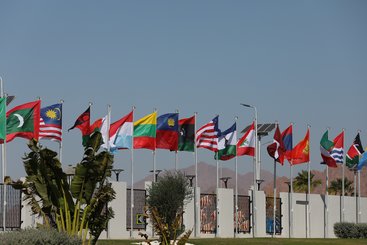ODI’s recently released paper A fair share of climate finance: the adaptation edition ranks countries in terms of how they are meeting their “fair share” of the commitment they collectively made in 2009 to provide and mobilize $100 billion of climate finance each year up until 2025.
To be clear, the commitment is one of collective ambition – there never was any agreement on how the $100 billion should be split among countries, nor was there an agreement on the methodology to be used to calculate how much each specific country should contribute. Also, neither China, Russia nor India is included on the list because those countries were encouraged to voluntarily provide financing, but they were not bound to doing so given their differentiated responsibility in changing the climate.
ODI devised a methodology using criteria that research authors believed would result in a fair calculation of each country’s proportional responsibility. The methodology factors in historical responsibility for cumulative greenhouse emissions, gross national income, and population size.
The analysis shows that the U.S. is only contributing 21% of what ODI has calculated should be the U.S. government’s “fair share” of the $100 billion pledge to help poorer countries. Is the U.S. falling far short? By many measures, we’re all falling short. The U.S., though, looks particularly bad given that it has been and continues to be one of world’s biggest emitters.
Climate campaigners would say the U.S. should be paying more. The U.S. has a long way to go to meet what ODI has determined would be a fair share to support climate action in poorer countries. The broken $100 billion promise has a lot to do with the U.S. government, along with others, not pulling its weight over the last ten years across multiple administrations. We’ve got a long way to go.
That said, we cannot delude ourselves into thinking that the U.S. government will be shamed into doing more to support the climate agenda. This misconception will not necessarily lead to a more productive result. The U.S. is a country with a high number of people who do not see climate change as a priority, or even an issue. Many of those same people will think that the U.S. already is spending too much money on this effort and more than its fair share given the dollar volumes provided. On the other hand, those who do see climate change as a pressing issue recognize the political and fiscal reality that presents real challenges for securing additional public resources. Plus, very few people in the U.S. (left- or right-leaning) agree that government has the primary role: the very heart of the U.S. model is to mobilize private capital and to support capital markets -- not for government to pay for everything.
More about fair share
Once again, the U.S. has been the second-poorest performer after Greece: it only provides 21% of what ODI researchers believe would be fair for the country to pay given its responsibility in climate change, economic might and population size. The paper indicates that the U.S. should pay $34 billion more, even if, in terms of dollar volume, the U.S government ranks 4th just behind Germany, France and Japan. Given that the situation is unlikely to change, what reflections can we offer for future advocacy?
While some might argue that the methodology penalizes the U.S. because of its high-income status, the reality is that the U.S. benefits from this methodology in a significant way because the methodology does not factor in that the U.S. is among the largest consumers of goods and services produced in other countries. In ODI’s methodology, the U.S. does not take any “hit” for the carbon emitted in manufacturing and shipping the vast quantity of products that Americans consume that are produced elsewhere – think of the fruits and vegetables available year-round in U.S. supermarkets, the vast quantity of cars that people drive, the inexpensive electronic equipment people spend hours on each day, the fast fashion clothing people wear, and all the other items on Walmart’s, Target’s, and T.J. Maxx’s shelves that are produced elsewhere and sold at rock-bottom prices in the U.S. As some say, if you’re paying $100 for a laptop, somebody somewhere is getting exploited.
Russia’s unnecessary war in Ukraine also has diverted significant public resources, particularly from the U.S., that could have otherwise been used for global development efforts. The U.S. remains the largest bilateral donor to the Ukraine war effort. One silver lining of the effort to counter Russia’s energy dominance in the region has been a concerted push to accelerate European energy independence, with a continued push to deploy more renewable energy to displace Russian gas.
But there is plenty the U.S. can do to play its part.
Now that we’ve gotten past the political context, let’s focus on what the U.S. can do with its existing resources or even limited additional resources to make a big difference in this narrowing public fiscal space.
The solutions
More blended and concessional financing
When the U.S. Congress established the U.S. International Development Finance Corporation (DFC), whether intentional or not, it reduced pressure on this development finance agency to earn a positive return on its total portfolio of investments. Both sides of the political aisle keep pushing DFC to do more of what it was designed for – to advance U.S. development and foreign policy priorities. Climate investments advance both. DFC has the authority to price its transactions to prioritize impact over financial return. That might include taking risk as a first mover in financing a project involving a new battery technology. It also means DFC could provide more favorable lending terms to a strategic infrastructure deal. If, for example, DFC provides a $10 million grant to support a $200 million loan to help a U.S. company secure the rights to develop a lithium or uranium mine (instead of it going to China or Russia), then DFC would be advancing both development and foreign policy priorities. DFC’s tools are available now. Members of Congress need to have DFC’s back if some of these investments do not earn large returns or even earn back $.90 on the dollar. That’s still great leverage of taxpayer resources.
Better aligning U.S. Agency for International Development (USAID) grants with DFC financing
USAID announced that it would aim to mobilize $150 billion in development financing. What better way to mobilize this financing than by having money readily available to quickly overcome obstacles to climate deals that DFC is pursuing? That’s what USAID successfully did, for example, through Power Africa when U.S. government financing of the Kipeto wind project in Kenya got stuck due to an environmental issue. USAID stepped in and funded a biodiversity impact mitigation plan that helped the project quickly reach financing close.
Fully funding Power Africa
At the African Leaders Summit in 2014, President Obama committed $300 million/year for 5 years for Power Africa. Power Africa only received one $300 million tranche of that $1.5 billion commitment. What Power Africa did with that one tranche was transformational. In its first few years, Power Africa used approximately $500 million of funding to work with its global partners to help 120 power projects worth $20 billion get across the finish line. It has helped 180 million people get access to electricity. That’s a leverage of 1:40 of U.S. money mobilizing capital to effect real change. Unfortunately, Power Africa’s budget was reduced significantly. Power Africa offers a little something for all – renewable energy investments, energy access, energy security AND the Just Transition. Imagine what Power Africa could achieve if it were to be fully funded.
Better Developing the Partnership for Global Infrastructure and Investment (PGII)
President Biden announced PGII during the G-7 Summit in 2022 to promote climate smart infrastructure investments in a way that offers an alternative to China’s Belt & Road Initiative. Unfortunately, no significant new resources seem to support this effort. Based on lessons learned from Power Africa, the U.S. and its G-7 partners could mobilize vast amounts of financing for critical infrastructure beyond just the power sector if a reasonable level of funding and human resources were dedicated to this effort.
What about mobilization?
The commitment text of 2009 is vague about the split between public and private finance to get to at least $100 billion. ODI’s analysis focuses on public finance, which is reported by countries. Private financing is not reported. But this means that the methodology does not factor in the massive amount of private finance for climate that comes from the U.S., including commitments from philanthropies like the Bezos Earth Fund to spend $1 billion/year over 10 years to support climate efforts. It does not factor in the vast resources that the U.S. government and private companies commit to research, development, and manufacturing for start-up efforts that deploy new technologies all over the world (e.g., Tesla). It is estimated that 90% of climate finance in the U.S. comes from private sources. That’s the U.S. model – minimize public spending as much as possible where there is a market-driven solution.
How’s the money spent?
Finally, a key constraint to the U.S., or any government for that matter, increasing its public expenditure of climate finance is the absorptive capacity of many countries where this financing would be directed. Power Africa, for example, saw a significant dip in the number of power projects reaching financial close in recent years, in part because many countries themselves struggle to create the institutional governance needed for these investments. See Seven Deadly Challenges of Investing in African Energy Infrastructure. If there were more projects to finance, public institutions would gladly finance hundreds of billions of dollars more each year. However, private financing needs to be given the first shot at financing these projects, otherwise the public institutions will distort the market. It also serves no great public interest to simply transfer vast amounts of public resources to regional and bilateral bodies that struggle to find projects to finance.
We have an opportunity and an obligation to make a genuine effort to overcome the constraints to climate projects. While there is plenty of blame to go around, we need practical solutions and not just financing commitments. There’s no shortage of money globally that wants to invest in projects that will improve the world for everyone.



